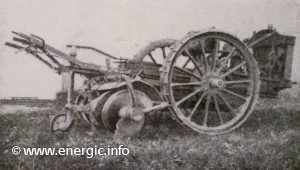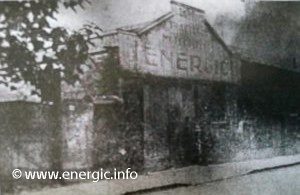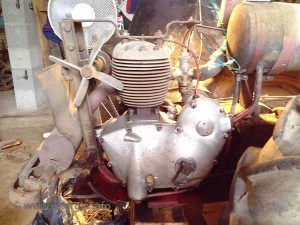History

Energic is a French brand of agriculture, viticulture machinery and garden equipment. This material was built from late 1929 to 1986 by the Patissier Establishments in Villefranche sur Saône in the Rhône (department 69 postal code 69400) – the capital of the Beaujolais viticulture industry- the starting point of viticulture machinery.

I am interested in the presently undocumented Energic history from the first prototypes to the start of the second world war, after which the history is much clearer. I have spent a long time researching, collecting and documenting what is available on pre-war Energic motoculteurs. I have pieced together fragments of information from many sources to form a credible Energic timeline. This is not definitive and will change as more information comes to light, but it is a starting point.
Early walk-behind tractors (renamed motoculteurs later on) offered mechanization and greater flexibility to smaller holder/farmers. Motoculteurs could be worked hard for longer periods of time than their counterparts the farm horse. In fact, they were sold on the basis of how much work they could do on an average day compared with actual horsepower. There are some statistics that say around the 1935/1940 period, 40% of France’s agricultural workers were still using horses as their main source of traction for agriculture. Before 1940 it was estimated there were 2 million horses used in agriculture.

Horse-drawn plough.

How much horsepower is available today.
These very early motoculteurs were, as a rule, extremely large, difficult/heavy to manoeuvre, underpowered with poor weight distribution. They proved very difficult to manoeuvre in tight situations or on steep slopes. Here are 3 examples of this type of motoculteur/tractor.



They used the tried and tested technology of the day that is where based around the available heavy car engines of the time modified onto a smaller chassis. After the first world war, their construction became more streamlined with the use of smaller motorcycle derived engines, that were re-geared for agricultural use. These machines were evolving quickly and, for the smallholder on a budget, were the first affordable mechanical alternative to the heavy horsepower.

Albert Patissier, born in 1900, was the inventor of the derailleur in 1920 (cycling) and test pilot at Monet-Goyon in Macon. He started off in a modest shop as a repairing business for cycles and various brands of motorcycettes (small motorcycles 50cc to 175cc) of that time at Rue National Villefranche-sur-Saône (in front of the L’Eden). there are records of the first registration of his company with 7,800,000 francs at this address in 1919 (reg; 57B136). (See Motobecane MB1 typical motorcycettes below). The company was fully trading in 1923.

Patissier moved his business after 2 years to Rue Paul Bert 1925 and then Rue du Promenoir in 1926. It was here and at la newly acquired warehouse at Rue des Docks that he started on the prototypes of motoculteurs for his viticole clients in 1926. This facility was close to the railway station for ease of finished product movement.

The large warehouse/hanger Rue des Docks near to the railway station at Villefranche-sur-Saône
He was contacted by a friend/viticulturist who purchased an early motoculture from Paris in 1926, who unable to successfully run a new type of motoculteur and was frustrated by its limitations. Mr Patissier analysed the machine, and it became evident that it was impossible to modify sufficiently to increase efficiency and to overcome the problems inherent in this basic design. So he set about constructing a prototype forming a new base design. This would be a limited range of motoculteurs that would be more suited to the purpose of polyculture, maraîchage and viticulture. Three machines were initially built under the brand name “Energic” in resplendent blue. They were sold.

M. Patissiers first motoculteurs were equipped with a 9cv Chaise petrol/essence engine. These motoculteurs were of a 4 wheel drive system, with solid disc wheels, With its overall width approx. 40cm – which was the standard width/distance between the rows of vines. Also within the design was a blockage system, to prevent wheel slippage, which operated by locking opposing wheels on opposing axles. Also, Mr Patissier used a special design of self-cleaning wheel design.
However, these motoculteurs also had their drawbacks, difficulty to steer, poor lateral stability, poor turning circle for the small parcels of land used by the viticulturist. Some 28 motoculteurs of this initial design were produced and 12/15 were sold. The size of the machine was dictated by the viticulters requirements to work on small parcels of difficult terrain, mainly on hillsides. In the Lyonnaise area.
Before any more were sold, Mr Patissier, at his own cost, recalled these first motoculteurs on the understanding that he would correct them fit for purpose. This was a very generous thing to do and fiscally very risky, as his fledgeling company had merger resources. This was make or break for him! It actually was the bedrock of the Energic companies work ethic moving forward, trust, honer able and honest using the best materials available with the latest technology. These first motoculteurs were replaced by what we recognize as the Energic B, C and G ranges of the future. Also interestingly the colour changed from the original blue to red with all 2 wheel drive machines of that date. (information from archives supported by Mr Jean Fleitou – who worked for Mr Patissier from the first machine production till 1967).
In 1930 Mr Patissier bought a further property at Rue Françoise Giraud, to keep his labour force in the local vicinity of his existing warehouse and premises.
In 1939 Mr Patissier then purchased a facility at Rue de Thizy, so that the engines stored here could be mounted easily on the motoculteur chassis.
Importantly Mr Patissier, when studying the other motorculteurs on the market at the time. Saw the possibility of developing an Implement towing arm/system d’attelage, to attach all manner of equipment to be trailed behind the motoculteur. He obtained a patent in France, England and Italy. This was a large step forward and set the marque ahead of the competition. This is the Brevete S.G.D.G. implement-attachment draw-bar-hitch

Read more about the Energic Brevete S.G.D.G. implement-attachment draw-bar-hitch here.
The competition in the French domestic market 1930/34, comprised of machines from the following manufacturers Pégase, Somua, Comiot-Graveix, Mesbla-Curtis and Bruneau.

Energic tracteur/motoculteur info.
Here is a range selector of the Energic motoculteurs, Moto-Treuil and Moto-Charrues 1929 to 1932.

Energic Tracteur/Moto-Culteur/Moto-Charrues/Moto-Treuil
The “Energic motoculteur B1” – a very manoeuvrable machine, utilizing a smaller engine with a patented Brevete S.G.D.G. design swing arm for multiple attachments – his first Motoculteur. This was not a stationary machine that could be used for multiple tasks from ploughing to harrowing. It used a 247cc Motobecane 2 stroke engine. Using a revolutionary simple mono spine chassis, which is the basis of all other machines from then on in the range. Very lightweight and versatile machine.

Energic type B machine 3/5 cv Motoculteur.
Read more about the Energic motoculteur B1 here.
The “Energic type A”. It was powered by a more powerful 500 cm3 ACT Chaise engine and available from before 1930. It was a stationary winch machine (Moto-Treuil). A lot of the viticulture was on very steep slopes where a winch (treuil) cable pulled a plough or other implements where required. To this end, the Energic Type A 9 (9cv) was adapted.

Energic Type A 9cv Chaise moteur. Moto-Treuil.
Read more about the Energic Moto-Treuil type A here.
Mr Patissier then sourced, through Motobecane, a “lateral valve” engine which was compact, weight-efficient, offering a lower centre of gravity and whose gearing and some internal parts could be modified to give longevity to the moteur for agricultural use (more load at lower speed). Thus the Energic motoculteur C7 (Motobecane 350cc (with the B4 lateral moteur) was created on the B platform design with modifications to the chassis to accept the moteur and drive chain. Their introduction showed significant improvements to the overall engine to weight power ratios. Offering a more compact design that was definitely more suited to the tasks. And with the later introduction of the Energic motoculteur D9, this design founded the basis of all models produced from then onwards up to 1939.

Energic motoculteur C7 with a B4L 7CV moteur.
Read more about the Energic motoculteur C7 B4L here.

Energic motoculteur G9 9cv. Moto-Charrue.
Read more about the Energic Moto-Charrue G9 9cv here.
It became obvious that even in their final developed state, the G9 machine also had engineering limitations. These issues could be better resolved with a further redesign and possibly a change to a more compact engine. The Energic G range models ran next to these models till 1933 when they were phased out in favour of the new design.
1932-33 Energic motoculteur models;
Type B (later call B5 in 1932/3 catalogues) 5cv motor 247cc 2 stroke 8% oil mixture.- (Motobecane) Originally with 1 speed and no rear gear (priced 5500fr.), then available with selectable rear gear drive (6850fr.)

Read more about the Energic motoculteur B5 here.
A later developed the Energic B the B5 E (Étroites) available from 1933 used the 5cv motor 247cc 2 temps – it was developed, by demand, for even narrower width requirements – special vine work.
Type C7 (replaced the type B4 5CV in1931) 7hp model Type 200 had selectable rear gear, 3-speed motor Motobécane B4L (lateral) bloc 346.7cm3 (this Motobécane engine was manufactured in various forms from 1930-34). But Energic seems to have used it till late 1934 when it was dropped as a current engine. It was replaced by the new more efficient S Bloc range, using a larger recirculating oil cooling & lubricating system necessitating a separate oil tank. Priced originally 7850fr. moving to 8500fr; in 1934/5) Crank handle start, with a hand-operated decompressor lever on the exhaust valve.
Read more about the Energic Motoculteur C7 B4L here.
Type D9 9hp 500cc B5L motobecane. Very rare this engine, in lateral form was only produced for less than one year and in 1931/2 was replaced by the S bloc. Was the replacement for the G9.
Read more about the Energic Motoculteur D9 B5L here.
Type G9 9hp model used a Chaise G 500cc 3 speed engine – very few motoculteur engined tractors were produced) I have physically seen a G9 model, and have the photos. They were phased out (1933) in favour of the Energic motoculteur C7 designed D9 with the introduction of the 1934 S Bloc Motobecane. (The S bloc being developed from the original B bloc which was available late 1933 in a 250cc form).
The Energic G9 models used a front motored kick start – derived straight from the motorcycle usage design. A handful of these models were produced as they were heavy to manoeuvre and expensive starting at 9250 fr. in 1932/3. (the Energic motoculteur C7 B4L was a better design was 2000fr cheaper, lighter, more fuel-efficient and would do a better job). Most G models were scavenged for parts for Chaise engine enthusiasts or scrapped.
Read more about the Energic Motoculteur G9 here.
** I have just recently found an Energic Motoculteur D9 B5L (M9) using a 9cv (500cc) Motobécane B Bloc lateral engine. Not much is known about these engines which were produced for a brief period of time (as motorcycle engines 1931/32) for Energic, with the Energic logo lettering cast into on the crankcase.
I have a satisfaction/reference letter from 10/10/1932, at Ecully, mentioning the 4/5cv 2 strokes – that will be one of the first B motored machines. And the first Energic motoculteur C7 appearing on 12/12/1932 in Toulouse – B bloc. This type of letter is submitted as a reference after a minimum of 12/18 months of satisfactory service. Dating Energic motoculteur B to the mid 1930 and the Energic motoculteur C7 B4L in mid/1931
Additionally within that period, (with no specific date) but available from 1934
Type E 2-3cv – traction one wheel motor 2 temps, 3 speed capable of pulling a small one soc plough, 30cm wide – very few manufactured (priced 3500 fr.). The engine size is not known but 100 – 150cm3 maximum – suitable Motobécane engines where available at this time).

Energic E traction.
Late 1933 – 1939/40
In Oct 1933 the new R/S bloc lateral 250cc, 350cc and 500cc became available from Motobécane. The 350cc and 500cc engines were fitted in the Energic C7 & D9 models respectively. (The B series Motobécane motored motoculteur/tiller was discontinued in favour of the S bloc – sometimes the plaques showed D9 M9 but had S9 motors in this transition period). Motobecane continues to manufacture the S bloc engine and use it in its motorcycles till after the war approx. 1947. (The bloc R being the Routier version, of the later Bloc S – in motorcycle trim). Energic machines use the R bloc but all are referred to as an S bloc in Motobécane engine terms, from its introduction, as this is the most common engine variant.
The new S bloc, with its increased oil/cooling and lubrication efficiency – through the use of a separate oil reservoir (tank) situated next to the fuel tank operating a float valve regulation. This was a big step forward in the motorization of the Energic motoculteur. The new moteurs probably came on stream with Energic motoculteur models from 1934, after spare and stock of the Motobecane B4L engines were used up.

Read more about the Energic motoculteur S bloc C7 here.
Read more about the Energic Motoculteur S bloc D9 here.
The C7/D9 motobecane S bloc Energic motoculteurs were still available up to 1944 (using up the old stock of parts and chassis). Their availability overlapped with the introduction of the totally new in house produced Energic motoculteur 409 3v (engines totally Energic – not outsourced). I have a machine that was bought new, one owner, in late 1944 a D9 (S bloc spec.). And I have seen an order dating from June 1942 for the New Energic motoculteur 409 awaiting homologué, with information showing authorizations relating the New 409 as early as 20 May 1941.

Bon De Commande dated 1/3/1940 for a Energic motoculteur D9

Finally what was very interesting and important to the Energic Brand, is its huge presence in the domestic market in France. There are some statistics that prove that the Energic brand held 68% of the French market in motoculteurs in the period up to and including 1938. Ahead of the other leading brands of Couaillac and Somua. A testament to the quality, reliability and technological break through’s led by Mr Patissier at Energic.

*******
Read more about the Ets Patissier model and range history after 1940.
Read more about the Ets Patissier factory history.
Read more about the Energic motoculteur B1 here.
Read more about the Energic motoculteur G9 here.
Read more about Energic motoculteur C7 B4L here.
Read more about Energic motoculteur D9 B5L here.
Read more about Energic motoculteur D9 S Bloc here.
Read more about Energic motoculteur C7 S Bloc here.
Read more about Energic History here.
See more on Facebook page: www.facebook.com/energic.info
If you like my Facebook page then I can put more information on it./ Si vous aimez ma page Facebook, je peux mettre plus d’informations à ce sujet.


